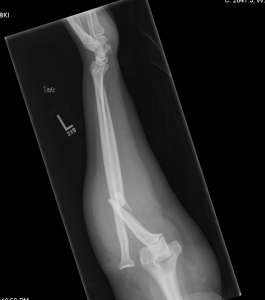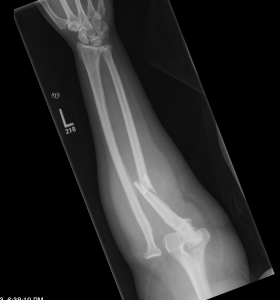Good job, Dr. Oiyemhonlan. This is a Monteggia fracture!
Monteggia Fractures
Overview:
Dislocation of the proximal radioulnar joint in association with a forearm fracture. Relatively uncommon. Less than 5% of all forearm fracture. Primarily associated with falls on outstretched hand with forced pronation. Radial head dislocation may lead to an injury of the radial nerve. The posterior interosseous branch of the radial nerve, which wraps around the neck of the radium. Most nerve injuries of neurapraxias, which resolved in 4-6 months.
Types:
Type I: fracture of the proximal or middle third of the ulna with anterior dislocation of the radial head.
Type II: fracture of proximal or middle third of the ulna with posterior dislocation of the radial head.
Type III: fracture of the ulnar metaphysis with lateral dislocation of radial head.
Type IV: fracture of the proximal or middle third of the ulna and radius with anterior dislocation of the radial head.
Treatment:
Medical therapy: tetanus and IV antibiotics for open fractures.
Pediatrics patients: emergent close reduction and splint application. Usually nonoperative treatment for closed fractures because majority of these fractures are stable.
Surgical indications: open fractures require emergent orthopedic intervention. In adult patients, closed fractures require surgical intervention electively.
References:
http://radiopaedia.org/articles/monteggia-fracture-dislocation
http://emedicine.medscape.com/article/1231438-overview
jwang
Latest posts by jwang (see all)
- Xray Vision Answer - May 24, 2015
- Xray Vision: My Arm Looks Funny…. - May 16, 2015
- Xray Vision: Limping Answer - April 27, 2015
- Xray Vision: Limping - April 17, 2015
- Xray Vision: Answer - March 27, 2015


